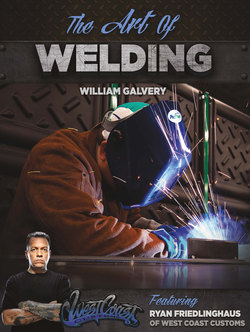Читать книгу The Art of Welding - William Galvery - Страница 12
На сайте Литреса книга снята с продажи.
Оглавление
SHIELDED METAL ARC WELDING
ARC WELDING AND STICK WELDING
This process is commonly known as “stick welding” or “arc welding,” but it is officially labeled as “shielded metal arc welding” (SMAW) by the American Welding Society. In this process, an electric circuit is established between the welding power supply, the electrode, the welding arc, the work, the work connection, and back to the welding supply. Electrons flowing through the gap between the electrode and the work produce an arc that provides the heat to melt both the electrode metal and the base metal. Temperatures within the arc exceed 6,000°F (3,300°C). The arc heats both the electrode and the work beneath it. Tiny globules of metal form at the tip of the electrode and transfer to the molten weld pool on the work. As the electrode moves away from the molten pool, the molten mixture of electrode and base metals solidifies and the weld is complete.
HOW DOES THE PROCESS WORK?
WHEN CAN SMAW BE USED?
WHAT IS THE BASIC EQUIPMENT SETUP FOR SMAW?
WHAT ARE THE FUNCTIONS OF SMAW ELECTRODES AND HOW ARE THEY SELECTED?
HOW IS SMAW EQUIPMENT SET UP?
STICK WELDING TIPS FROM WEST COAST CUSTOMS
How does the process work?
courtesy of Lincoln Electric]
The electrode is coated with a flux. Heat from the electric current causes the flux’s combustion and decomposition. This creates a gaseous shield to protect the electrode tip, the work, and the molten pool from atmospheric contamination. The flux contains materials that coat the molten steel droplets as they transfer to the weld and become slag after cooling. This slag also floats on the weld puddle’s surface and solidifies over the weld bead when cool, where it protects the molten metal and slows the cooling rate. The flux coating on some electrodes contains metal powder to provide additional heat and filler to increase the deposition rate. The electrode flux and metal filler electrode determine the chemical, electrical, mechanical, and metallurgical properties of the weld as well as the electrode handling characteristics. Only 50% of the heat power furnished by the power supply heats the weld; the rest is lost to radiation, the surrounding base metal, and the weld plume. See Figure 4-1.
Figure 4-1. The Shielded Metal Arc Welding process
When can stick welding be used?
